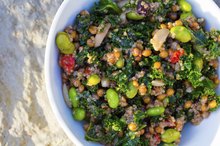Vitamins for an Overactive Bladder
Overactive bladder, also known as OAB occurs when your bladder is unable to function normally. An overactive bladder causes a sudden urge to urinate and may result in an involuntary loss of urine. A variety of factors such as stretched or weak pelvic muscles, chronic urinary tract infections, bladder diseases, an enlarged prostate, diabetes or obesity can trigger an overactive bladder. Vitamins may improve bladder function.
If you are experiencing serious medical symptoms, seek emergency treatment immediately.
Vitamin A
The recommended daily dosage for vitamin A is 900 mcg for men and 700 mcg for women. Foods rich in vitamin A include:
- cod liver oil
- butter
- eggs
- milk
- baked sweet potatoes
- mangoes
- broccoli
- squash
- canned pumpkin
- raw carrots
- spinach
Vitamin B-12
Vitamins for Mononucleosis
Learn More
Foods rich in vitamin B-12 include:
- rainbow trout
- milk
- plain yogurt
- beef liver
- top sirloin beef
- white tuna
- salmon
- breakfast cereals
- eggs
- roasted chicken
Vitamin C
The recommended daily dosage for vitamin C is 1,000 mg for adults. Foods rich in vitamin C include:
- cranberries
- strawberries
- blackberries
- grapefruits
- pineapples
- kiwi
- broccoli
- oranges
- Brussels sprouts
- spinach
- tomatoes
Vitamin D
Vitamins and Minerals for Fever Blisters
Learn More
Foods rich in vitamin D include:
- canned pink salmon
- fortified soy milk
- fortified cereals
- egg yolks
- fortified orange juice
- fortified cow’s milk
- sardines
Related Articles
References
- “The Vitamin D Cure”; Diane Stafford; 2009
- “Vitamins and Minerals Demystified”; Steve Blake; 2007
- “About the Natural Treatments for Urinary Incontinence: Using Butterbur and Other Natural Supplements to Treat Bladder Control Problems”; Rita Elkins; 2000
- “Clinician's Guide to Holistic Medicine”; Robert A. Anderson; 2001
- “Vitamins, Herbs, Minerals, & Supplements: The Complete Guide”; H. Winter Griffith; 2000
- “Vitamins for Dummies”; Christopher Hobbs; 1999
Writer Bio
R. Y. Langham served as a senior writer for "The Herald" magazine from 1996-99. Langham holds a Bachelor of Arts in English from Fisk University, a Master of Science in marriage and family therapy from Trevecca Nazarene University and a Ph.D in family psychology from Capella University. Dr. R.Y. Langham published her first psychological thriller in September 2011. It can be purchased on Amazon.com, Barnes&Noble.com and Lulu.com.









